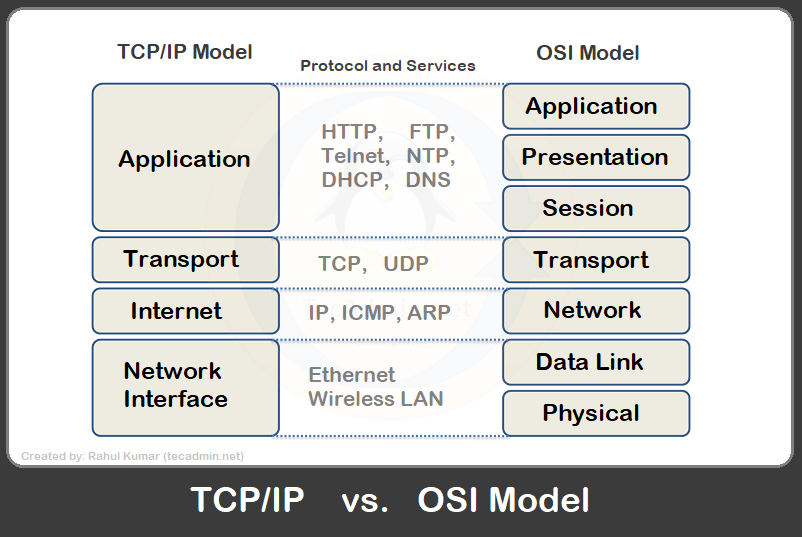When it comes to digital communications, two models have established their roles as the pillars for understanding and describing how different network protocols interact and work together: the Transmission Control Protocol/Internet Protocol (TCP/IP) and the Open Systems Interconnection (OSI) model. Both models have their unique structures, strengths, and applications, which this article aims to explore.
TCP/IP Model
The TCP/IP model, named after two of its most important protocols, Transmission Control Protocol (TCP) and Internet Protocol (IP), is a concise and practical framework for network communications. Developed during the 1970s as part of a project by the Defense Advanced Research Projects Agency (DARPA), the TCP/IP model was built to fulfill the needs of the ARPANET project, which later became the foundation for the internet.
The TCP/IP model is composed of four layers:
- Network Interface Layer: This bottom-most layer is responsible for handling the physical transmission of data, which includes aspects like hardware, drivers, and network interface cards. It corresponds roughly to the Physical and Data Link Layers in the OSI model.
- Internet Layer: This layer, also known as the Network layer, is responsible for sending packets across potentially multiple networks, with network hosts identified by IP addresses. Protocols like IP, ICMP, and ARP are part of this layer.
- Transport Layer: TCP and UDP protocols exist at this layer. They provide host-to-host communication services for applications. TCP provides a reliable, connection-oriented service, while UDP provides a connectionless, unreliable service.
- Application Layer: This is the top-most layer, and it is responsible for high-level protocols that most applications use, such as HTTP, SMTP, FTP, etc.
OSI Model
The Open Systems Interconnection (OSI) model is a conceptual framework that standardizes the functions of a communication system into seven abstract layers. Developed by the International Organization for Standardization (ISO), the OSI model aims to provide a comprehensive understanding of network communication.
The seven layers of the OSI model include:
- Physical Layer: This layer is responsible for the actual physical connection between devices, which includes aspects such as voltages, physical data rates, and network topology.
- Data Link Layer: This layer establishes a reliable direct point-to-point data connection between two network nodes. It covers error detection and correction, as well as hardware addressing.
- Network Layer: The Network layer is in charge of packet forwarding, including routing through different networks.
- Transport Layer: The Transport layer handles quality of service, connection control, and recovery from failed transmissions.
- Session Layer: This layer manages communication sessions, i.e., service requests and responses between applications.
- Presentation Layer: This layer manages data formats, as well as the encryption and decryption required for secure data transmission.
- Application Layer: The top-most layer of the OSI model is responsible for application services interacting with the network. This layer covers protocols like HTTP, SMTP, and FTP, similar to the Application layer in the TCP/IP model.

A Comparative Study
While the OSI model’s layered approach offers a detailed, modular framework that is excellent for understanding, teaching, and visualizing how different network protocols interact, the TCP/IP model is more focused on practical application and real-world use.
- Simplicity: With four layers instead of seven, the TCP/IP model is simpler and less detailed, which can make it easier to understand for those new to network protocols.
- Basis of Development: The OSI model was developed as a theoretical model to understand and describe how different network protocols interact, while the TCP/IP model was developed to meet the practical and physical needs of the then-nascent internet.
- Usage: The TCP/IP model is more widely used in the actual implementation of real-world networks. Most of today’s internet is based on the TCP/IP model, making it the de facto standard.
- Layer Names and Services: The OSI model has explicit delineation between its layers and their functions, with each layer providing a specific group of services. The TCP/IP model, however, is not that explicit about the services within its layers.
- Universality: The OSI model has a universal scope and is designed to describe any and all possible network interactions. In contrast, the TCP/IP model is more focused on internet-related protocols and data transmission modes.
Conclusion
In conclusion, both models serve critical roles in the field of network communication. The choice between using TCP/IP or the OSI model often depends on the context. TCP/IP is generally better suited for practical implementation and is more commonly used for real-world network traffic. On the other hand, the OSI model is commonly used as a comprehensive teaching tool to give students an all-encompassing understanding of network communications.